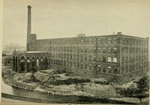St Michael and All Angels' Church, Ashton-under-Lyne
Anglican Diocese of ManchesterBuildings and structures in Ashton-under-LyneChurch of England church buildings in Greater ManchesterGrade I listed churches in Greater Manchester

St. Michael's Church (also known as, St. Michael and All Angels' Church) is an Anglican parish church in Ashton-under-Lyne, Tameside, Greater Manchester, England. The church is a Grade I Listed Building. The church dates back to at least 1262, and a church on the site was mentioned in the Domesday Book. The church was rebuilt in the fifteenth century; however little of the previous church remains after it was rebuilt again in the nineteenth century and is still an active place of worship.
Excerpt from the Wikipedia article St Michael and All Angels' Church, Ashton-under-Lyne (License: CC BY-SA 3.0, Authors, Images).St Michael and All Angels' Church, Ashton-under-Lyne
Scotland Street, Tameside Hurst
Geographical coordinates (GPS) Address External links Nearby Places Show on map
Geographical coordinates (GPS)
| Latitude | Longitude |
|---|---|
| N 53.487675 ° | E -2.089699 ° |
Address
Ashton Parish Church (St Michael's)
Scotland Street
OL6 6XN Tameside, Hurst
England, United Kingdom
Open on Google Maps







